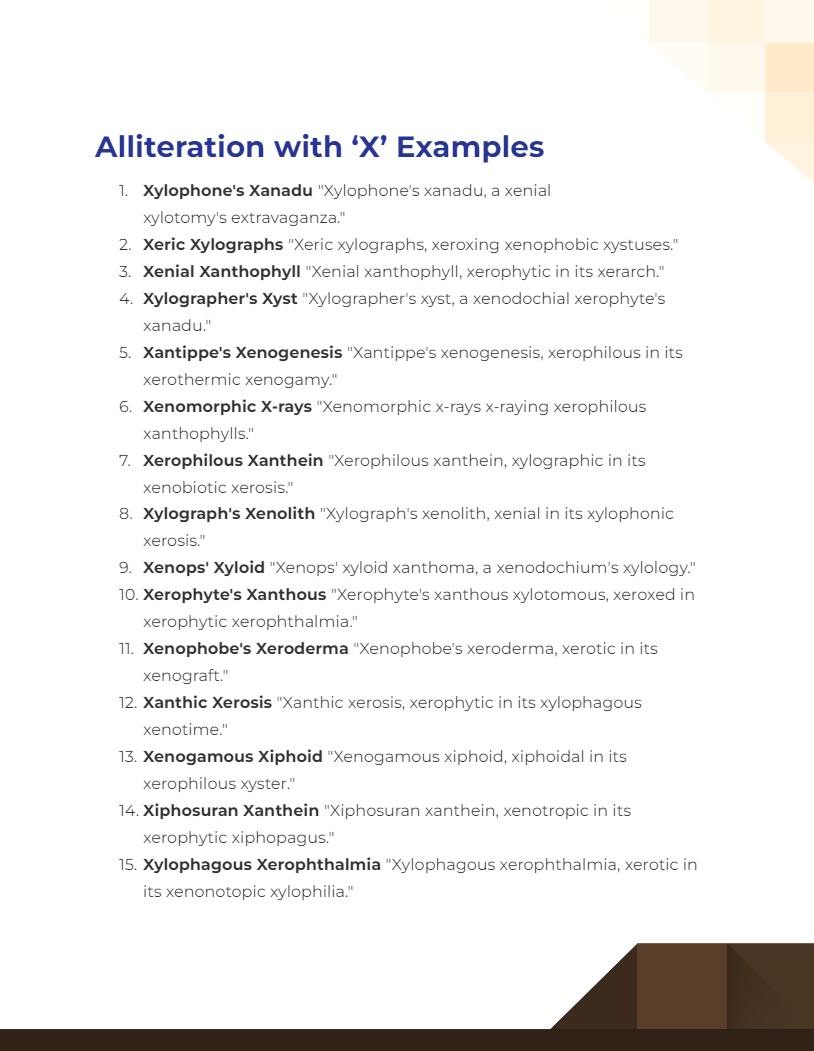Alliteration with X
Alliteration, the art of using the same consonant sound at the beginning of adjacent words, can be a captivating literary device. When it comes to alliteration with the elusive letter ‘X,’ crafting compelling phrases can be both challenging and rewarding. In this article, we’ll explore some intriguing examples of ‘X’-based famous alliteration, delve into the techniques for creating it effectively, and provide valuable tips to master this linguistic art form. Let’s dive into the world of ‘X’-citing alliteration!
Download Alliteration with 'X' Examples
Download Alliteration with 'A' to 'Z' Examples
What is the Best Example of Alliteration with ‘X’?

Example: A classic example of alliteration with the letter ‘X’ is the phrase “Xander’s xylophone produced xenophobes’ xenial xenogenesis.”
Meaning: Alliteration is a literary device that involves the repetition of the same initial consonant sound in a sequence of words or phrases. Finding alliteration with the letter ‘X’ can be quite challenging due to the limited availability of words that start with ‘X.’ In the example, “Xander’s xylophone produced xenophobes’ xenial xenogenesis,” the repetition of the ‘X’ sound at the beginning of various words creates a unique and distinctive linguistic pattern. This kind of easy alliteration can be rare but is creatively employed to emphasize the sound and rhythm of the language.
20 Alliteration with ‘X’ Examples

Download Alliteration with 'X' Examples in PDF
Alliteration with the letter ‘X’ creates a xylophonic xanadu of xenial and xeric xylographs, offering an exotic and often exhilarating auditory experience. The ‘X’ sound, known for its rarity and sometimes mystique, is perfect for crafting hard alliteration examples. Especially effective in alliteration in rhymes, the ‘X’ sound adds an extraordinary and engaging dimension to verses. Here are 20 unique examples of alliteration with ‘X’, each complemented by a rhyme title that encapsulates the essence of the phrase.
- Xylophone’s Xanadu “Xylophone’s xanadu, a xenial xylotomy’s extravaganza.”
- Xeric Xylographs “Xeric xylographs, xeroxing xenophobic xystuses.”
- Xenial Xanthophyll “Xenial xanthophyll, xerophytic in its xerarch.”
- Xylographer’s Xyst “Xylographer’s xyst, a xenodochial xerophyte’s xanadu.”
- Xantippe’s Xenogenesis “Xantippe’s xenogenesis, xerophilous in its xerothermic xenogamy.”
- Xenomorphic X-rays “Xenomorphic x-rays x-raying xerophilous xanthophylls.”
- Xerophilous Xanthein “Xerophilous xanthein, xylographic in its xenobiotic xerosis.”
- Xylograph’s Xenolith “Xylograph’s xenolith, xenial in its xylophonic xerosis.”
- Xenops’ Xyloid “Xenops’ xyloid xanthoma, a xenodochium’s xylology.”
- Xerophyte’s Xanthous “Xerophyte’s xanthous xylotomous, xeroxed in xerophytic xerophthalmia.”
- Xenophobe’s Xeroderma “Xenophobe’s xeroderma, xerotic in its xenograft.”
- Xanthic Xerosis “Xanthic xerosis, xerophytic in its xylophagous xenotime.”
- Xenogamous Xiphoid “Xenogamous xiphoid, xiphoidal in its xerophilous xyster.”
- Xiphosuran Xanthein “Xiphosuran xanthein, xenotropic in its xerophytic xiphopagus.”
- Xylophagous Xerophthalmia “Xylophagous xerophthalmia, xerotic in its xenonotopic xylophilia.”
- Xyster’s Xylophobia “Xyster’s xylophobia, xerophilous in its xylotomous xenogenesis.”
- Xenotransplant’s Xylography “Xenotransplant’s xylography, xerophilous in its xystus xeransis.”
- Xylophilous Xerarch “Xylophilous xerarch, xenomorphic in its xylographic xylotomy.”
- Xerophytic Xylotomist “Xerophytic xylotomist, xenial in its xylophilous xeransis.”
- Xylotomous Xenocryst “Xylotomous xenocryst, xerophilous in its xylotomous xenolith.”
Alliteration Sentence Examples with ‘X’
Alliteration sentence examples with ‘X’ often exude an exotic or mysterious vibe, utilizing the unique ‘X’ sound to create an intriguing rhythm. This type of alliteration is rare and can add a distinctive flavor to literary works, including alliteration in poems, songs, and movies. Here are three examples:
- “Xander explored the xeric xanadu with excitement.”
- “The xanthous x-ray fish exhibited extraordinary xylography.”
- “Xenia’s xylophone exuded a xenial, exhilarating melody.”
Alliteration Examples with ‘X’ Words
Alliteration examples using ‘X’ words demonstrate the consonant’s ability to create complex, intriguing phrases. These examples, though challenging due to the rarity of ‘X’ words, can add a unique element to alliteration in songs. Here are three examples:
- “The xenagogue’s xiphoid x-rays were xeroxed expertly.”
- “Xylia’s xiphoid xylographs were extraordinary in their xerography.”
- “Xenon lights x-rayed the xylopolist’s xanthic artifacts.”
Alliteration Tongue Twisters with ‘X’
Alliteration tongue twisters with ‘X’ are a playful way to challenge pronunciation skills, focusing on the repetition of the ‘X’ sound. These tongue twisters can be both fun and educational, aiding in speech development and pronunciation. Here are three examples:
- “Xavier’s xiphoid xylophone played xanthous xylitol melodies.”
- “Xerxes fixes six xylophones with exquisite xenon tools.”
- “Xanthippe and Xerxes played xylophones in xenophobic xenogamy.”
Alliteration Starting with ‘X’
Alliteration beginning with ‘X’ sets a specific tone and rhythm in a phrase, often creating an extraordinary and impactful auditory experience. Found in various artistic expressions, including alliteration in movies, it adds a distinctive flair. Here are three examples:
- “Xerophilous xanthomas expanded across the x-ray.”
- “Xanthic xerus xeroxed xylotomy diagrams.”
- “Xenia’s xylophone xeroxed xenophilous melodies.”
How to Write Alliteration with ‘X’?
Writing alliteration with the letter ‘X’ involves creatively incorporating words that start with the ‘X’ sound, which can be a challenging but rewarding endeavor due to the rarity of ‘X’ words. This type of alliteration is used in various contexts, including educational settings for first graders and in more complex alliteration in figurative language. Here’s a guide to crafting effective alliteration with ‘X’:
- Understand the ‘X’ Sound: Familiarize yourself with the ‘X’ sound, which often sounds like ‘Z’ at the beginning of words (e.g., xylophone) and can have a ‘ks’ sound in the middle or at the end of words (e.g., fox).
- Choose a Theme or Concept: Select a theme or subject that allows for the creative use of ‘X’ words. This is essential for crafting meaningful phrases or sentences, whether for educational purposes or creative writing.
- Brainstorm ‘X’ Words: Compile a list of words that start with ‘X’ or contain ‘X’. Consider using a dictionary or online resources, as ‘X’ words can be less commonly known.
- Create Your Phrase or Sentence: Arrange your chosen ‘X’ words to form a coherent sentence or phrase. Focus on maintaining a natural flow while highlighting the alliterative effect.
- Read Aloud for Rhythm: Audibly assess the effectiveness of your alliteration. Read your sentence aloud to ensure it flows well and the ‘X’ sound is clear.
- Revise for Clarity and Impact: Make sure your alliterative phrase is clear and contributes effectively to your overall message or story.
- Apply in Various Contexts: Adapt your use of ‘X’ alliteration with answers for different purposes and audiences, whether it’s in alliteration figurative language exercises, as part of teaching alliteration for first grade, or in creative writing.
Tips for Using Alliteration with ‘X’
Here are the Tips for Using Alliteration with ‘X’:
- Embrace Creativity: Given the rarity of ‘X’ words, using alliteration with ‘X’ requires creativity. Don’t hesitate to use unusual or less known words.
- Maintain Relevance: Ensure that your ‘X’ alliteration is relevant to your topic or story. Avoid forcing ‘X’ words into your writing where they don’t fit naturally.
- Consider Your Audience: Tailor your alliteration for first grade to your audience. For first graders, use simpler ‘X’ words and concepts, whereas for adults, you can explore more complex ‘X’ alliterations.
- Use Phonetic Variations: Remember that ‘X’ can produce different sounds. Use this to your advantage to create diverse alliterative effects.
- Balance with Other Words: Since ‘X’ words are rare, balance them with other words to maintain the flow and coherence of your writing.
- Explore Different Forms: Try ‘X’ alliteration in various forms of writing. It can add a unique twist to poetry, stories, and even academic or promotional writing.
- Review and Refine: Read your work aloud, refine it, and make sure it achieves the desired alliterative effect without compromising the content’s quality.
Alliteration for adults with ‘X’ can add an intriguing and distinctive element to your writing, making it stand out and captivate your audience.
What are the Alliteration with ‘X’ for Kids?
Alliteration with ‘X’ for kids involves creating engaging and playful phrases that utilize the ‘X’ sound, a rare and exciting consonant in the English language. This form of alliteration can spark interest and curiosity in children, making it a fun way to learn about unique sounds and words. Examples designed for alliteration for kids include:
- “Xavier’s x-ray fish made an exciting exhibit at the aquarium.”
- “Xena the xenops chirped excitedly in the xylophone store.”
- “Xandy the fox played the xylophone under the xanthous moon.”
These examples are tailored to be approachable and enjoyable for children, fostering their interest in language and phonetics.
What is the Effect of ‘X’ Letter in Alliteration?
The effect of the ‘X’ letter in alliteration is to create an exotic and sometimes mysterious sound that adds a unique and intriguing quality to language. The ‘X’ sound, being less common in English, draws attention and can make phrases stand out. In literature, ‘X’ alliteration is often used to add an element of intrigue or to highlight a particular aspect of the narrative. It’s a versatile sound, capable of adding a dynamic quality to various forms of writing, from alliteration for kids, where it can be playful and engaging, to more sophisticated works for adults. The ‘X’ sound is also important in alliteration and assonance, contributing to the overall sonic appeal of a piece.
What is the Alliteration ‘X’ Type of?
Alliteration with the letter ‘X’ is a type of consonantal alliteration, where the consonant sound at the beginning of adjacent or closely connected words is repeated. This form of alliteration is rare and can be quite challenging due to the limited number of words starting with ‘X’. The ‘X’ type of alliteration can create different effects, from exotic and intriguing to more playful and whimsical, depending on the context and the words chosen. This form of alliteration is seen in a range of literary contexts and is particularly effective in educational materials for its unique appeal, widely used in alliteration for students and alliteration for kids. The ‘X’ alliteration’s ability to add a unique and memorable quality to writing makes it a valuable tool for writers and educators


